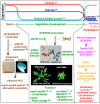Biology and Function of miR159 in Plants
- PMID: 31366066
- PMCID: PMC6724108
- DOI: 10.3390/plants8080255
Biology and Function of miR159 in Plants
Abstract
MicroR159 (miR159) is ancient, being present in the majority of land plants where it targets a class of regulatory genes called GAMYB or GAMYB-like via highly conserved miR159-binding sites. These GAMYB genes encode R2R3 MYB domain transcription factors that transduce the gibberellin (GA) signal in the seed aleurone and the anther tapetum. Here, GAMYB plays a conserved role in promoting the programmed cell death of these tissues, where miR159 function appears weak. By contrast, GAMYB is not involved in GA-signaling in vegetative tissues, but rather its expression is deleterious, leading to the inhibition of growth and development. Here, the major function of miR159 is to mediate strong silencing of GAMYB to enable normal growth. Highlighting this requirement of strong silencing are conserved RNA secondary structures associated with the miR159-binding site in GAMYB mRNA that promotes miR159-mediated repression. Although the miR159-GAMYB pathway in vegetative tissues has been implicated in a number of different functions, presently no conserved role for this pathway has emerged. We will review the current knowledge of the different proposed functions of miR159, and how this ancient pathway has been used as a model to help form our understanding of miRNA biology in plants.
Keywords: GAMYB; aleurone; flowering; miR159; programmed cell death; tapetum; vegetative growth.
Conflict of interest statement
The authors declare no conflict of interest.
Figures



Similar articles
-
The microRNA159-regulated GAMYB-like genes inhibit growth and promote programmed cell death in Arabidopsis.Plant Physiol. 2010 Oct;154(2):757-71. doi: 10.1104/pp.110.160630. Epub 2010 Aug 10. Plant Physiol. 2010. PMID: 20699403 Free PMC article.
-
Ubiquitous miR159 repression of MYB33/65 in Arabidopsis rosettes is robust and is not perturbed by a wide range of stresses.BMC Plant Biol. 2016 Aug 19;16(1):179. doi: 10.1186/s12870-016-0867-4. BMC Plant Biol. 2016. PMID: 27542984 Free PMC article.
-
GAMYB controls different sets of genes and is differentially regulated by microRNA in aleurone cells and anthers.Plant J. 2006 Aug;47(3):427-44. doi: 10.1111/j.1365-313X.2006.02795.x. Epub 2006 Jun 22. Plant J. 2006. PMID: 16792694
-
miR159 Represses a Constitutive Pathogen Defense Response in Tobacco.Plant Physiol. 2020 Apr;182(4):2182-2198. doi: 10.1104/pp.19.00786. Epub 2020 Feb 10. Plant Physiol. 2020. PMID: 32041907 Free PMC article.
-
Regulation of Non-coding RNAs in Heat Stress Responses of Plants.Front Plant Sci. 2016 Aug 18;7:1213. doi: 10.3389/fpls.2016.01213. eCollection 2016. Front Plant Sci. 2016. PMID: 27588021 Free PMC article. Review.
Cited by
-
Maize Lethal Necrosis disease: review of molecular and genetic resistance mechanisms, socio-economic impacts, and mitigation strategies in sub-Saharan Africa.BMC Plant Biol. 2022 Nov 23;22(1):542. doi: 10.1186/s12870-022-03932-y. BMC Plant Biol. 2022. PMID: 36418954 Free PMC article. Review.
-
miRNAs and Their Target Genes Play a Critical Role in Response to Heat Stress in Cynodon dactylon (L.) Pers.Mol Biotechnol. 2023 Dec;65(12):2004-2017. doi: 10.1007/s12033-023-00713-2. Epub 2023 Mar 13. Mol Biotechnol. 2023. PMID: 36913082
-
The Characters of Non-Coding RNAs and Their Biological Roles in Plant Development and Abiotic Stress Response.Int J Mol Sci. 2022 Apr 8;23(8):4124. doi: 10.3390/ijms23084124. Int J Mol Sci. 2022. PMID: 35456943 Free PMC article. Review.
-
Soybean miR159-GmMYB33 Regulatory Network Involved in Gibberellin-Modulated Resistance to Heterodera glycines.Int J Mol Sci. 2021 Dec 6;22(23):13172. doi: 10.3390/ijms222313172. Int J Mol Sci. 2021. PMID: 34884977 Free PMC article.
-
The Sw5a gene confers resistance to ToLCNDV and triggers an HR response after direct AC4 effector recognition.Proc Natl Acad Sci U S A. 2021 Aug 17;118(33):e2101833118. doi: 10.1073/pnas.2101833118. Proc Natl Acad Sci U S A. 2021. PMID: 34385303 Free PMC article.
References
-
- Chávez Montes R.A., de Fátima Rosas-Cárdenas F., De Paoli E., Accerbi M., Rymarquis L.A., Mahalingam G., Marsch-Martínez N., Meyers B.C., Green P.J., de Folter S. Sample sequencing of vascular plants demonstrates widespread conservation and divergence of microRNAs. Nat. Commun. 2014;5:3722. doi: 10.1038/ncomms4722. - DOI - PubMed
Publication types
LinkOut - more resources
Full Text Sources

